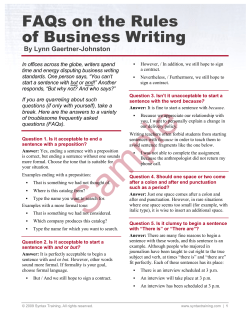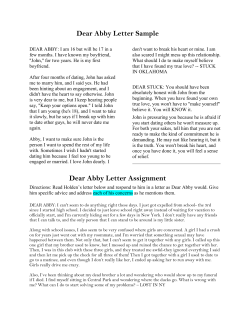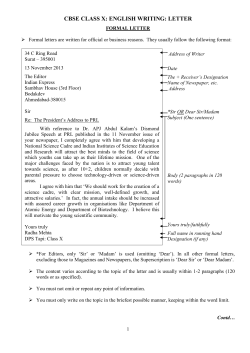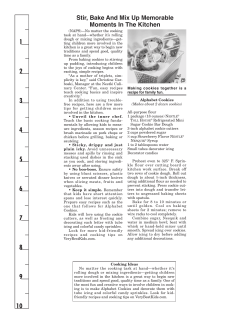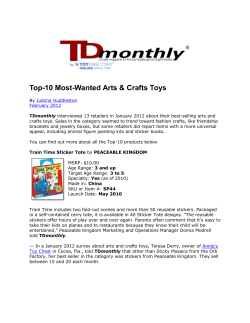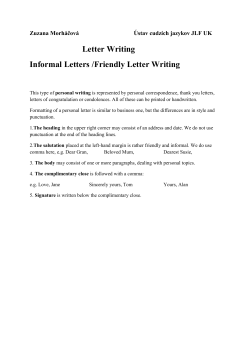
A L F A
A Letter to Families About Block Play Dear Families, The hardwood unit blocks you see in our classroom are one of the most valuable learning materials we have. They come in exact sizes and shapes. For this reason when children build with blocks they learn math concepts such as the number of blocks that fill a certain space. They compare the height of their buildings and learn about geometric shapes (triangles, squares, and rectangles). When they lift, shove, stack, and move blocks, they explore weight and size. Each time they use blocks, children are making decisions about how to build a structure or solve a construction problem. Children often use blocks to recreate the world around them—a road, a house, the zoo. They work together and learn to cooperate and make friends. We encourage children to talk about what they are doing to promote language development. We also talk with children and ask questions to expand on their block play. For example, we might say: I see you built a tall apartment house. How do the people get to their floor? Where do people park their cars when they come to visit the shopping center? Would you like to make a sign for your building? These questions and comments make children more aware of what they are doing and encourage them to try out new ideas. What You Can Do at Home You can encourage your child to learn through block play by taking an interest in what he or she does at our program. Come spend time in our Block Area to see your child building and caring for blocks. When you take a walk in your neighborhood, point out roads and interesting buildings. You may want to purchase table blocks, colored wooden cube blocks, or cardboard brick blocks to have at home. You can also make a set out of milk cartons, which come in different sizes. Store them in shoe boxes or plastic tubs and containers and put a picture and written label on the container so your child knows where these materials belong. Identify a place where your child can build and play with the blocks safely. Props such as clothespins, small plastic animals, and cars and trucks will extend your child’s play and inspire new ideas. The settings your child creates can be used for pretend play as well. © 2002 Teaching Strategies, Inc. Permission is granted to duplicate the material on this page for use in programs implementing The Creative Curriculum® for Preschool. A Letter to Families About Computers Dear Families, In our program we are delighted to have computers as learning tools for the children. Here are some of the things children learn when they use computers: • to be comfortable with technology • beginning reading and writing skills • math skills and concepts such as counting and numerical relationships • how to express themselves creatively • how to solve problems and begin to do research We encourage children to work at the computer in pairs or small groups. This helps them learn from each other and develops their social skills at the same time. While the children are working at the computer, we ask them questions to help them think about what they’re doing: “What made you decide to choose this program to work on?” “How can we use the computer to send a copy of your painting to your grandparents?” “What would you like to do with the printouts you made today?” By working with children in these ways, we not only encourage their growth and development but also help prepare them for a future in which they will need to know how to work with computers. What You Can Do at Home You may or may not have a computer in your home. It is certainly not necessary that you do for your child to benefit from our program’s Computer Area. If you do have a home computer and would like to know some things that you can do with your child, please ask. We will be glad to provide you with assistance, including how to judge which programs and Internet sites are appropriate for use with young children. We have some good information on this topic that we’d like to share with you. You may be interested in visiting our program to observe how children use computers. If you’d like to volunteer to work with children in the Computer Area, we’d be delighted to have your help. You may even enjoy learning more about computers yourself! © 2002 Teaching Strategies, Inc. Permission is granted to duplicate the material on this page for use in programs implementing The Creative Curriculum® for Preschool. A Letter to Families About Cooking Dear Families, Cooking is an important part of our Curriculum. When children cook, they have an opportunity to learn about nutrition, to be creative, and to prepare their own healthy snacks. Cooking teaches a lot of academic skills too. When children learn to follow picture recipe cards, they develop skills they need to read and write. Measuring 1 cup of flour and pouring 1/4 teaspoon of lemon juice into batter gives them a lesson in math. Whipping egg whites into meringue and melting cheese under a broiler are lessons in science. When children cook, we talk a lot about what they are doing and why. They are scientists, observing what happens to flour when we add water to it and predicting how high we should fill a muffin tin so the batter doesn’t overflow. When we prepare the special foods of each family, your child learns to appreciate the cultures of everyone in our class. Perhaps you have some favorite family recipes that you would like to share with us. Please give them to us at any time. We’d like it, too, if you could come to our Cooking Area and introduce the class to your child’s favorite foods. Cooking is a very special part of our program. It is one of the few activities children get to do that is also done by adults. Children pretend to be grown-ups making meals in their dramatic play. They can read books and sing songs about food. But in cooking, children can actually behave as grown-ups. What You Can Do at Home Since cooking is already a part of your home life, think about involving your child. Including your child may take extra time, and there may be more of a mess than if you cooked alone, but there are many rewards. Your child will be learning literacy, math, and science skills just by helping you. In addition, cooking sets the stage for lifelong healthy eating habits. When children help prepare their meals, they tend to eat better. Start your child on simple tasks like stirring batter, squeezing lemons, adding spices, or shaping meatballs. Discuss what you are doing together while cooking. Ask questions like these. What happened to the butter when we put it in the microwave? How should we get the flour into this cup? Did we get all the juice out of that lemon? Let’s push down on the lemon together and see what happens? The beauty of cooking with children is that they learn skills and have fun at the same time you are attending to a household chore. What could be better than that! © 2002 Teaching Strategies, Inc. Permission is granted to duplicate the material on this page for use in programs implementing The Creative Curriculum® for Preschool. A Letter to Families About Music and Movement Dear Families, We do a lot of singing and creative movement in our program. Singing and moving to music give the children a chance to hear and appreciate different kinds of music, express themselves through their movement, and practice new skills. The children love our daily time for singing together, and it helps them learn to cooperate in a group. Here are some of the things we do to encourage a love for music and movement. •We listen to all different kinds of music. •We play instruments to make our own music. •We give the children colored scarves and paper streamers to use as they move to the music. •We use chants to help us get through the daily routines, such as clean-up time. •Sometimes we take a tape recorder outside and play jazz or folk music, and the children dance and act out songs. What You Can Do at Home You don’t have to play an instrument or sing on key to enjoy music with your child. Taking a few minutes to sit together and listen to music can provide a welcome break for both of you. Also, the music you share with your child doesn’t have to be “kid’s music” only. It can be reggae, country, jazz, classical, rap, or any other music you like. Here are some ideas for enjoying music and movement with your child. •Children love a song or chant about what they are doing at the moment, especially when it uses their name. While pushing your child on a swing, you might chant, “Swing high, swing low, this is the way that [your child’s name] goes.” •Songs and fingerplays help keep children occupied at challenging times, for instance, during long car trips, while waiting in line, or when grocery shopping. •Songs can ease your child into tasks like picking up toys, getting ready to go outside, undressing for a bath, and so on. You might try making up a chant to the tune of “Here We Go ‘round the Mulberry Bush” such as, “water is filling up the tub, up the tub, up the tub. . . ” or “Pick up a toy and put it on the shelf, put it on the shelf. . . .” •Musical instruments can be made or improvised at home easily. You (or your child) already may have discovered that cooking pots and lids make wonderful instruments. Sharing music with your child is a wonderful way to build a warm, loving relationship. It’s a gift that will last forever. © 2002 Teaching Strategies, Inc. Permission is granted to duplicate the material on this page for use in programs implementing The Creative Curriculum® for Preschool. A Letter to Families About Sand and Water Play Dear Families, Although you’re probably used to seeing your children splash in the bathtub and dig in a sandbox at the playground, you may be surprised to know that the Sand and Water Area is an important part of our school program. Both sand and water are natural materials for learning. When children pour water into measuring cups, they are exploring math concepts. When they drop corks, stones, feathers, and marbles into a tub of water, they are scientists exploring which objects float and which sink. When they comb sand into patterns, they learn about both math and art. We encourage children to experiment with these materials. As they do, we ask questions to focus their thinking on their discoveries: Now that we’ve turned the water blue, what should we do with it? How did the water change when we added the soap flakes? What can wet sand do that dry sand can’t? What can dry sand do that wet sand can’t? How many of these measuring cups of water do you suppose it will it take to fill this quart pitcher? What You Can Do at Home If your child particularly enjoys playing with water and sand, you may want to set up some play areas for these activities in your home. Water play can be set up at the bathroom or kitchen sink. Lay a large towel on the floor, and if the sink is too high for the child, provide a stool or stepladder. Outdoors, you can use a small wading pool, tub, or old baby bathtub. Give your child a baster, plastic measuring spoons and cups, a funnel, and plastic or rubber animals and boats. Or for a novel experience, add soap flakes or food coloring to the water. And don’t forget about blowing bubbles with your child. Try using different kinds of bubble blowing frames. Plastic six-pack rings, empty berry containers, or an eyeglass frame without the lenses make interesting bubble wands. If a sandbox is not available outdoors, you might use a small dishpan as a miniature sandbox. All you need is a few inches of fine white sand. Collect small items such as shells, rubber animals, a very small rake, coffee scoops, measuring cups and spoons, sieves, and funnels and offer them to your child, a few at a time. These props will lead to many hours of enjoyment for your child. The opportunity to play with sand and water on a regular basis helps children to develop their minds and bodies in relaxing and thoroughly enjoyable ways. © 2002 Teaching Strategies, Inc. Permission is granted to duplicate the material on this page for use in programs implementing The Creative Curriculum® for Preschool. A Letter to Families About the Discovery Area Dear Families, Young children have many questions about the world around them. They ask: “Where did the puddle go?” “What do worms eat?” “How can I make my truck go faster?” “Do fish go to sleep?” In our classroom, the Discovery Area is a place where children can explore and investigate to answer their questions. They observe, experiment, measure, solve problems, take things apart, and explore the materials and living things we put out. They guess what will happen as a result. In the Discovery Area children do what scientists do—ask questions, plan and conduct investigations, gather information, construct an explanation, and communicate findings. They also learn important concepts in science as they study plants, animals, magnets, properties of materials, light, shadows, how things work, rainbows, our body, our senses, how things move and change, and more. In addition to learning science content, they learn how to solve problems together and how to communicate with others. What You Can Do at Home Young children are curious and love to investigate. You don’t need to be an expert to help your child learn about science. Science is all around us—from making bubbles in the bathtub to boiling water on the stove. Your enthusiasm and positive attitude about science will be contagious. Get in the habit of wondering out loud (“I wonder how that ant can carry that big piece of food.” “I wonder why your shadow is sometimes small and sometimes big.”). The kinds of questions you ask and statements you make when your child is exploring will help develop his scientific thinking skills. Here are some examples: What do you think will happen if. . . ? I wonder why. . . How do think we can find out. . . ? Look for opportunities to develop your child’s scientific thinking during everyday activities: while playing with toys, taking a bath, helping to bake cookies, playing in the backyard, or going on an outing. Remember, you don’t need to know all the answers! It’s a good sign if your child is curious, wants to discover everything, asks lots of questions, and wants more answers. We welcome you to come and visit our Discovery Area with your child. © 2002 Teaching Strategies, Inc. Permission is granted to duplicate the material on this page for use in programs implementing The Creative Curriculum® for Preschool. A Letter to Families About the Library Area Dear Families, The Library Area is a very important part of our classroom and of your child’s life. It’s where children gain the foundation for reading and writing. It’s also a place where children can relax and enjoy the wonderful world of children’s books. We encourage children to look at books, to listen to taped stories, to retell stories, and to scribble and “write” throughout the day. Sometimes children dictate stories to us, which we record in books.” We read stories to the children every day. Reading introduces new ideas, helps children learn how to handle problems that come up in life, and mostly encourages them to develop a love for books. As children listen to us read, their own reading skills begin to develop. Here are some of the things we do as we read. • We look at pictures and ask: “What do you see?” • We encourage children to predict what will happen next: “What do you suppose will happen now?” • We encourage children to repeat words, rhymes, and phrases they’ve memorized. What You Can Do at Home Research has shown us the important role families play in helping children learn to read and write. The single most important thing you can do is to read to your child every day. When your child sits next to you as you read, he begins to connect books with good feelings. Here are a few more things you can do with your child. • Encourage your child to talk about the stories you read. • Ask questions like, “I wonder what will happen next?” or “I wonder why . . .” • Try to relate the story to something in your child’s life (“That dog looks just like Grandpa’s”). • Visit the library and check out books that interest your child. • Give your child paper and pencils, pens, or markers and let him experiment with writing. Don’t worry if his writing isn’t perfect! If you’d like some help choosing books––or guidance on how to read with your child––please come see us. To keep your child’s home library well stocked, you can draw on the resources of your local public library. When you take time to read to your child every day, you are doing the very best thing to help your child grow up to be a successful reader. © 2002 Teaching Strategies, Inc. Permission is granted to duplicate the material on this page for use in programs implementing The Creative Curriculum® for Preschool. A Letter to Families About Art Dear Families, Art is an important part of our curriculum. Every day, children find a variety of art materials available on our shelves. Drawing, painting, pasting, molding and constructing are not only enjoyable but also provide important opportunities for learning. Children express original ideas and feelings, improve their coordination, learn to recognize colors and textures, and develop creativity and pride in their accomplishments by exploring and using art materials. When children are engaged in art activities, we talk with them about what they are doing and ask questions that encourage them to think about their ideas and express feelings. We are just as interested in the creative process as we are in what children make. We say things that will encourage children to be creative and confident, such as: Tell me about your picture instead of Is that a house you made? It looks like the playdough is sticking to your fingers. What could we do to make it less sticky? What You Can Do at Home Art is a very easy way to bring your child’s school life into your home. Children love to bring home their art products to share with the most important people in their lives. Take time to talk with your child. Here are some things you might say: Tell me about your picture. How did you decide which colors to use? What do you like best about it? Should we hang it up in a special place so we can all enjoy your work? You can help your child appreciate art right in your home. When you look at books together, talk about the illustrations with your child. Discuss the art on the walls in your home. Art is something your child can do at home in almost any room. You might designate a drawer in the kitchen or living room as an art drawer, or use a bookshelf or sturdy cardboard box. In this space include crayons, marking pens, paper, a pair of child-sized, blunt-edged scissors, glue, and a separate box for collage materials. A child’s mind is much more creative and artistic than any coloring book allows. © 2002 Teaching Strategies, Inc. Permission is granted to duplicate the material on this page for use in programs implementing The Creative Curriculum® for Preschool. A Letter to Families About Toys and Games Dear Families, Toys and games include puzzles, various table blocks, small construction materials such as Legos, board games, and collections of objects (including shells, bottle caps, and buttons). When children use toys and games, they explore how things work; learn to be creative and use their imaginations; strengthen and control the small muscles in their hands; work cooperatively and solve problems; and learn math ideas and concepts. When children use toys and games in the classroom, we encourage them to talk about what they are doing. For example, we might say: Tell me about the design you made. How did you get those rings to fit together? You’ve picked out all blocks that look the same. Can you tell me how they are the same? These questions and comments are designed to help children develop their thinking skills. What You Can Do at Home You play an important role in selecting toys and games that are safe, interesting, and appropriate for your child’s abilities. More importantly, research shows that the most creative children are those who have had adults involved in their play. Here are a few ways that you can be involved in your child’s play with toys and games: •Observe. Watch as your child plays and notice his abilities and his interests. •Play. Follow your child’s lead and join in his play. •Imagine. Keep in mind that there’s more than one way to play with a toy. Be creative! •Enjoy. This isn’t a time to drill your child or test him on what he knows. Just have fun being together, talking, and playing. Good toys do not have to be expensive. You might collect various small objects such as buttons, seashells, rocks, and plastic bottle tops. Make suggestions such as sort all the buttons that are the same color or all the beads that are the same size. Encourage your child to tell you about the design he or she is making or to explain why things belong together. Playing with toys and games at home promotes a child’s development in many ways. We welcome you to help us out in the classroom by playing in our Toys and Games Area with the children. In this way you can see for yourself how much your child is learning there. © 2002 Teaching Strategies, Inc. Permission is granted to duplicate the material on this page for use in programs implementing The Creative Curriculum® for Preschool. A Letter to Families About Dramatic Play Dear Families, In the Dramatic Play Area children take on different roles and recreate real-life experiences. They use props and make-believe to deepen their understanding about the world they live in. The ability to pretend is very important to your child’s development. Children who know how to make believe develop a good vocabulary, which is important for reading. They learn to cooperate with others and solve problems, and are able to think abstractly—all important skills for success in school. When children pretend, they have to recall experiences and re-create them. To do this, they need to picture their experiences in their minds. For example, to play the role of a doctor, children have to remember what tools a doctor uses, how a doctor examines a patient, and what a doctor says. In playing the doctor or other roles, children learn to cooperate with others and to share their ideas. When children make believe, we might ask: Is your baby sick? What are you going to do? Are you the storekeeper here? I need to buy some food. What are you cooking for dinner tonight? It smells so good. We talk with children and participate in their play to extend their thinking. What You Can Do at Home You can encourage the same kind of pretend play at home that we do at school simply by playing with your child and providing some simple props. A sheet over a table creates a house or a hideout. A large empty cardboard box can become almost anything—a pirate ship, a doghouse, a castle, or a train. The nice thing about dramatic play is that it requires only your imagination. Here are some simple ways to encourage your child’s learning through dramatic play: • During bath time, include plastic boats, cups, and rubber dolls and play pretend. • Save food cartons, make some play money, and play store with your child. • Read stories together and involve your child in acting out different parts of the story. • Collect some old clothes your child can use to dress up and make believe. • Say to your child, “Let’s pretend we’re going on a train ride. What do we need? Tickets? Suitcases? Do you want to collect the tickets?” When you engage in pretend play with your child, you are teaching important learning skills, and you are spending valuable time together. © 2002 Teaching Strategies, Inc. Permission is granted to duplicate the material on this page for use in programs implementing The Creative Curriculum® for Preschool. Chapter 16: Outdoors A Letter to Families About Outdoor Play What We Do and Why Physical exercise and fresh air are important for your child’s health and well being. We take children outdoors every day so they can run, jump, swing, climb, and use all the large muscles in their bodies. They run around, breathe in the fresh air, look at the clouds, or catch a ball or a bug. They lie on the ground and watch clouds and birds, or they climb high and look down. We also talk about the things children see, hear, touch, and feel so they become aware of changes in the weather, the seasons, the growth of plants, and the animals. Playing outdoors your child can learn •to notice and appreciate changes in nature •to discover how water puddles after a rain and disappears when the sun comes out •to follow shadows around •to use his or her body in increasingly skillful ways We encourage children to wonder about what they see by asking questions: What do you notice? Where do you think they are going? How are they different or the same? What You Can Do at Home Fresh air and exercise are very important to your child’s health, and to yours. Try to spend time with your child outdoors every day except when the weather is dangerous. Take walks in your neighborhood, go to parks together, explore nature with your child. Watch what your child notices and show you too are interested. Children love to collect things and then play with them, sort them, and make patterns with them. Bring along a container or plastic bag when you go outdoors so your child can collect treasures along the way—seeds, leaves, rocks—and bring them home to examine. You also can plan special activities outdoors. Here are some ideas: •Bring drawing paper and crayons outside so children can draw what they see. •Take a pail of water and large brushes so your child can paint the sidewalk or fence. •Bring colored chalk, which is perfect for sidewalk art. •Play catch with balls of all sizes. •Bring bubble-blowing solution and different-shape blowers. Make time each day to be outdoors with your child, exploring, making discoveries, and appreciating nature. 522 © 2002 Teaching Strategies, Inc. Permission is granted to duplicate the material on this page for use in programs implementing The Creative Curriculum® for Preschool.
© Copyright 2025



